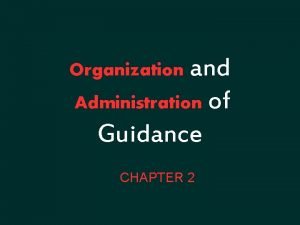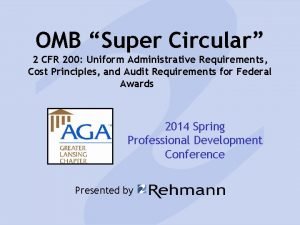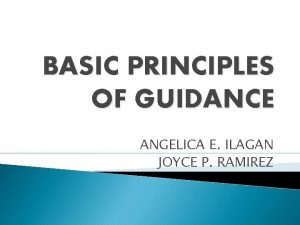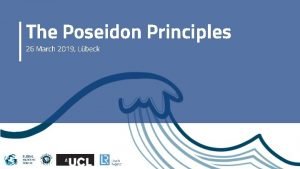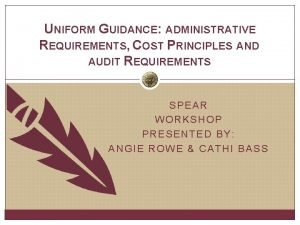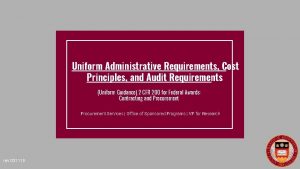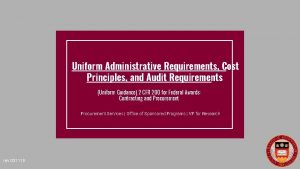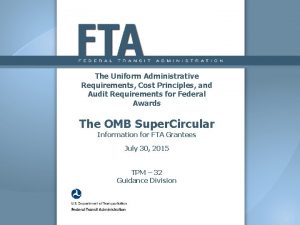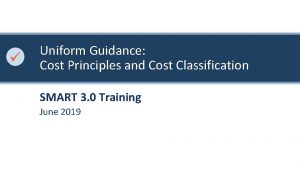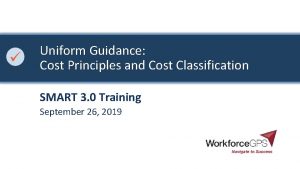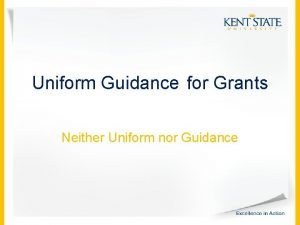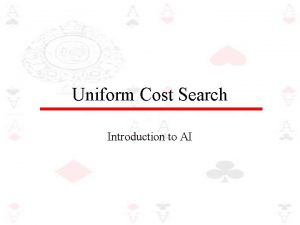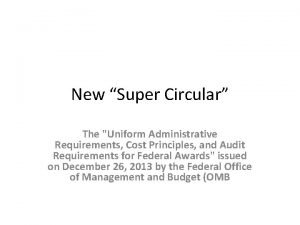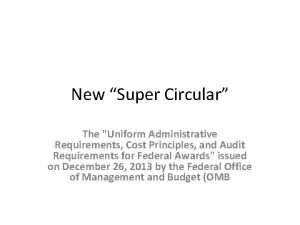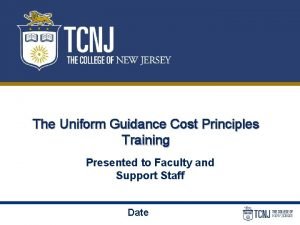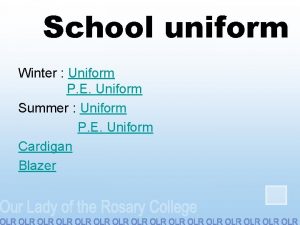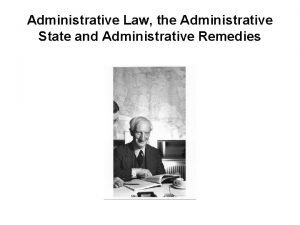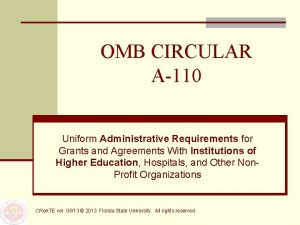UNIFORM GUIDANCE Uniform Administrative Requirements Cost Principles and


























- Slides: 26

UNIFORM GUIDANCE Uniform Administrative Requirements, Cost Principles, and Audit Requirements for Federal Awards Presented by Colleen Ravenfeld Office of Research Administration

WHAT IS THE UNIFORM GUIDANCE? The White House Office of Management and Budget (OMB) has combined 8 federal circulars into a single document known as Uniform Guidance. In TJU’s case, the Uniform Guidance supersedes and streamlines requirements from 3 OMB Circulars. • A-21 Cost Principles for Educational Institutions • A-110 Uniform Administrative Requirements • A-133 Audit Requirements The Council on Financial Assistance Reform (COFAR) was delegated the responsibility of developing the Uniform Guidance, with the goal of reducing administrative burden while improving oversight and accountability.

WHAT IS THE UNIFORM GUIDANCE? • Addresses the administration’s goal of a government that is more efficient, effective and transparent. • Strengthens requirements for INTERNAL CONTROLS while providing administrative FLEXIBILITY for non-Federal entities. • The Uniform Guidance applies to new awards and incremental funding to existing awards made on or after 12/26/14. • The Uniform Guidance is located in Title 2 of the CFR, Part 200 (2 CFR 200).

UNIFORM GUIDANCE TIMELINE December 26, 2013 OMB issued the Uniform Guidance June 26, 2014 Due date for the Federal agencies to submit proposed implementation plans to the OMB to allow for review and public comment December 26, 2014 Uniform Guidance goes into effect June 30, 2015 End of Jefferson’s first fiscal year under the new Uniform Guidance July 1, 2015 Uniform Guidance Audit Requirements are applicable to Jefferson awards July 1, 2016 Changes to the Procurement Provisions under the new Uniform Guidance go into effect

UNIFORM GUIDANCE WORKING GROUP GOALS 1. Analyze the changes in UG against the requirements in the previous OMB circulars; 2. Develop a workplan to ensure a systematic assessment of the scope of the changes against the current Jefferson policies and operating guidelines; 3. Recommend actions needed to conform with implementation by December 26, 2014 The group sought input of Jefferson subject matter experts, including representatives from: Audit Finance Enterprise Risk Research Administration International Office Human Resources Office of Legal Counsel Provost’s Office Supply Chain Management Innovation Pillar Leaders RACE Compliance Conflict of Interest Office

HOW IT’S ORGANIZED TITLE Subpart A INCLUDES: Acronyms & Definitions Sections 0 -99 Subpart B General Provisions Applicability Sections 100 -113 Subpart C Sections 200 -211 Subpart D Sections 300 -345 Subpart E Pre-Federal Award Instructions to the awarding agency (or Requirements & Contents pass-through entity) of Federal Awards Post Federal Award Requirements Standards for Financial & Program Managements Instructions to the recipient, including Internal Controls, Cost Sharing, Program Income, Budget/Program revisions, Procurement Standards, Subrecipient Monitoring, Closeout Cost Principles Allowability, Prior Approval, Direct/Indirect classifications, F&A , Selected Items of Cost Audits Audit requirements Sections 400 -475 Subpart F Sections 500 -521

Appendix I through IX Applicable appendices include: • App. I Full Text of Notice of Funding Opportunity • App. II Contract Provisions for Non-Federal Entity Contract s Under Federal Awards • App. III Indirect (F&A) Costs Identification and Assignment, and Rate Determination for Institutions of Higher Education (IHEs) • App. IX Hospital Costs

NEW TERMS

NEW TERMS • Computing devices means machines used to acquire, store, analyze, process, and publish data and other information electronically, including accessories for printing, transmitting and receiving, or storing electronic information. (200. 20) • Fixed amount awards means a type of grant agreement under which the Federal agency or pass-through entity provides a specific level of support without regard to actual costs incurred under the federal award. (200. 45) • Micro-purchase means a purchase of supplies or services using simplified acquisition procedures, the aggregate amount of which does not exceed the micro-purchase threshold, which is currently $3, 000. (200. 67) • Participant support costs means direct costs for items such as stipends or subsistence allowances, travel allowances, and registration fees paid to or on behalf of participants or trainees (but not employees) in connection with conferences, or training projects. (200. 75)

SIGNIFICANT CHANGES

INTERNAL CONTROLS Section 200. 303 Recipients of federal funding must: • establish and maintain effective internal controls that provide reasonable assurance that Jefferson is managing its awards in compliance with Federal statutes, regulations and the terms and conditions of the award. • Evaluate and monitor compliance and take prompt action when instances of non-compliance are identified • Take reasonable measures to safeguard protected personally identifiable information The UG emphasizes the importance of having documented internal controls.

COST SHARING Section 200. 306 The UG reinforces the fact that voluntary committed cost sharing is neither expected nor considered during merit review of the proposal. Voluntary committed cost sharing is cost sharing that was included in the proposal but was not a sponsor requirement. Federal agencies must require mandatory cost sharing or not consider it at all. It must be clearly defined in the funding opportunity. Unrecovered indirect costs (including indirects on cost sharing) may be considered cost sharing only with agency prior approval. The UG supports Jefferson’s strong discouragement of voluntary committed cost sharing because of it’s financial and administrative burden.

REVISION OF BUDGET & PROGRAM PLANS Section 200. 308 The following budget or program deviations require prior approval from the awarding agency: • Change in scope or the objective of the program • Change in a key person specified in the application • PI disengagement from the project for more than 3 months or a 25% reduction in time (effort) devoted to the project • Inclusion of costs that require prior approval • Transfer of funds budgeted for participant support costs • Subawarding or contracting work out unless described in the application and funded • Changes in the amount of cost sharing provided by the nonfederal entity

PROCUREMENT Sections 200. 317 through 326 The UG provides detailed methods by which institutions should procure goods and services when funded by a federal award which includes stricter requirements for sole-source purchases. The UG emphasizes the documentation requirements and internal written procedures for procurement. The OMB is providing a grace period to comply with these standards, during which the University will modify or develop procedures to comply with the UG.

SUBRECIPIENT AND CONTRACTOR DETERMINATIONS Section 200. 330 • Provides a list of characteristics which support classification as a subrecipient (federal assistance relationship) or a contractor (procurement relationship) • “Contractor” replaces “vendor” • Clarifies that the pass-through entity determines the classification on a case-by-case basis

REQUIREMENTS FOR PASS-THROUGH ENTITIES Section 200. 331 • Includes a standard list of information that must be included in all subawards • Requires institutions to perform a risk assessment of subrecipients prior to issuing subagreements in order to determine the appropriate level of monitoring. The UG provides the critieria for determining risk, which includes prior experience and audit results • Requirements for subaward monitoring

REQUIREMENTS FOR PASS-THROUGH ENTITIES Section 200. 331 F&A ON SUBAWARDS: • Pass through entities are expected to honor a subrecipient’s negotiated rate agreement • When a subrecipient has a federally negotiated F&A rate, the negotiated rate must be included in all proposed subawards • Guidance clarifies that if a subrecipient does not already possess a negotiated Indirect Cost Rate, it may apply a de minimus rate of 10%. (see section 200. 414) It is not permissible for the PI to force or entice a proposed sub without a negotiated rate to accept less than the de minimis rate

ADMINISTRATIVE & CLERICAL SALARIES Section 200. 413 The UG clarifies that the salaries of administrative and clerical staff should normally be treated as indirect costs. Direct charging of these salaries can be considered only if ALL of the following criteria is met: • Services are INTEGRAL to the project; • Individual can be specifically identified with the project; • Cost has been explicitly included in the budget OR have written prior approval from the awarding agency; and • Costs are not also recovered as indirect costs Proposal budget justification should clearly detail the integral nature of the services to the project.

INDIRECT (F&A) COSTS Section 200. 414 • The negotiated rate must be accepted by all Federal awarding agencies

COMPENSATION Section 200. 430 Standards of documentation: Salary charges to sponsored projects must be based on records that accurately reflect the work being performed. Those records must: • Be supported by a system of internal control which provides reasonable assurances that the charges are accurate, allowable and properly allocated • Be incorporated into our official records • Encompass both federally funded and all other activities • Support the distribution of the employees salary among specific activities While OMB A-21 examples and references to formal effort reporting has been replaced with new terminology, emphasis has been placed on internal controls. Jefferson’s current effort reporting system is considered an effective internal control to ensure that compensation charges to Sponsored Projects are accurate, allowable and properly allocated and will continue with no material changes

COMPUTING DEVICES Section 200. 453 • The UG clarifies that computing devices are generally considered to be “supplies” and can therefore be directly charged to sponsored projects as long as they are essential and allocable to the performance of the award. • No longer need to be “solely dedicated” • Computing devices costing $5, 000 or more must be treated as equipment. • The proposal budget justification should clearly explain why the device is essential to the project. • NEW FORM! RACE requires for modular budgets or when the need for a device is identified in the postaward stage. • Section 200. 403 “Factors affecting allowability of costs” continues to apply.

PUBLICATION AND PRINTING COSTS Section 200. 461 The UG allows for the “cost of publication or sharing of research results” to be charged to the project even if the costs were incurred after the end of the performance period--BUT before final financial closeout. The expense would need to be included on the final reconciliation.

TRAVEL Section 200. 474 The UG relies on Jefferson’s established travel policy to determine the allowability of travel costs. Documentation must justify that participation of the individual is “necessary” to the federal award. Expect a comprehensive revision of the travel policy to coincide with the rollout of the new CONCUR travel approval system.

HOSPITAL COST PRINCIPLES Appendix IX to Part 200 • 45 CFR Part 74 Appendix E “Principles for Determining Costs Applicable to Research and Development Under Grants and Contracts with Hospitals” remain in effect • OMB has proposed a review process to consider how best to update and align those principles with the UG.

SUMMARY OF NEW POLICIES AND REVISIONS 110. 23 Costing Guidelines for Sponsored Projects 110. 25 Unallowable Costs for Sponsored Projects 110. 24 Cost Sharing and Matching Funds for Sponsored Projects 110. 09 Status Change for Principal investigators and Key Personnel on Sponsored Projects 110. 01 Authorization for Consultant Services Required Sponsored Projects 110. 06 Effort Certification for Exempt University Staff on Sponsored Projects 110. 07 Effort Certification for Non-Exempt University Staff and All Hospital Employees on Sponsored Projects 110. 20 Sub-recipient Monitoring on Sponsored Projects 110. 21 Program Income 110. 22 Principal Investigator Role and Responsibilities for Sponsored Projects

TOOLS – 3 GUIDES 1. ) Is it a direct or indirect cost? Clarifies how Jefferson typically incurs selected items of cost (as either a direct or indirect cost). 2. ) Proposal Guide. Provides detail regarding allowability for selected items of cost. 3. ) What Requires Prior Approval From a Federal Agency? Provides a comprehensive list of circumstances for which prior approval is specifically required.
 10% de minimis indirect cost rate uniform guidance
10% de minimis indirect cost rate uniform guidance Balanced occlusion factors
Balanced occlusion factors Indirect guidance
Indirect guidance Principles of guidance according to crow and crow
Principles of guidance according to crow and crow Guidance organizational structure
Guidance organizational structure Omb super circular 2 cfr 200
Omb super circular 2 cfr 200 Basic principles of guidance
Basic principles of guidance The poseidon principles
The poseidon principles Melinda haley
Melinda haley Conclusion of counselling
Conclusion of counselling Principles of guidance
Principles of guidance Principles of guidance
Principles of guidance How do you classify uniform and non-uniform mixtures?
How do you classify uniform and non-uniform mixtures? Homogeneous mixture
Homogeneous mixture Aliran tak seragam
Aliran tak seragam Linear motion images
Linear motion images Cost accumulation and cost assignment
Cost accumulation and cost assignment Cost accumulation and cost assignment
Cost accumulation and cost assignment Cost accumulation and cost assignment
Cost accumulation and cost assignment Cost accumulation and cost assignment
Cost accumulation and cost assignment Cost control and cost reduction difference
Cost control and cost reduction difference Standard costs meaning
Standard costs meaning Distinguish between average cost and marginal cost
Distinguish between average cost and marginal cost Cost control and cost reduction difference
Cost control and cost reduction difference Job-order-costing-vs-process-costing
Job-order-costing-vs-process-costing Ordering cost and carrying cost
Ordering cost and carrying cost Actual cost and opportunity cost
Actual cost and opportunity cost




